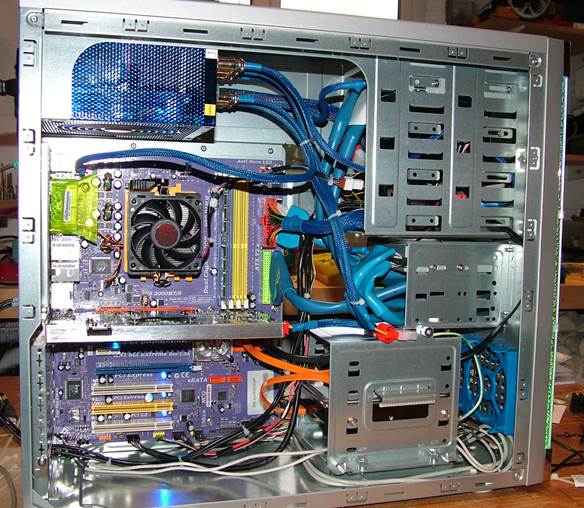5. Cannibalize Your Old System to Save Money
If you’re replacing an existing computer,
don’t just throw it in a cupboard and forget about it. Dismantle that sucker
for parts. While it’s true that a lot of components will be too outdated to be
of any use, that doesn’t mean none of it’s any good. Stripping out old pieces
can save you tens, if not hundreds of pounds.

If
you’re replacing an existing computer, don’t just throw it in a cupboard and
forget about it. Dismantle that sucker for parts. Stripping out old pieces can
save you tens, if not hundreds of pounds.
Storage, in particular, tends to be robust
enough to make the transfer. Aside from the introduction of SA TA and steadily
increased capacities, hard drives have more or less stayed the same for
decades. If you have a hard drive in your old computer, transferring it to a
new one will give you extra space at no cost. The only thing to beware of is
bad sectors. Older drives can physically wear out, so do a thorough scan before
you start using it properly.
Other components worth hanging onto include
optical drives, expansion cards and peripherals like keyboards, mice, monitors
and speakers. Cases and PSUs can also persist through multiple computers
without any ill effects. If you’re replacing a fairly recent PC, even your RAM
might be reusable.
On the flip side of that argument, graphics
cards, motherboards and processors are unlikely to carry over into a new
machine, but don’t think that buying a new PC means you have to get everything
shrink-wrapped. There’s life in the old dogs yet.
6. Make Use of Short-term Sales and Daily Deals
As a way to encourage repeat visits, many
component websites put up short-term sales deals. Sometimes they last for 24
hours, sometimes for a week, but it’s always the same conditions: once they’re
out of stock, the price sheds its discount for the foreseeable future.

Use
of Short-term Sales and Daily Deals
This means that if you want to get a deal,
you have to be persistent. We suggest that you bookmark the pages and visit
them first thing in the morning just to see what’s on offer. Admittedly, you
might spend a lot of time closing tabs offering printer cartridges, optical
media and thermal compound, but occasionally, the processor, RAM or solid-state
drive you were hoping to get hold of will be the one discounted, and that’ll
make it the right time to pull the trigger on your purchase.
7. Don’t Get Hung Up on Processor Speeds
In the old days, a processor’s clock speed
was the way you told how good it was, but don’t worry too much about that any
more. Whether a system is 2GHz or 3GHz no longer matters as much as the overall
architecture. Pay attention to the number of cores and cache memory on a chip;
the higher those values, the better the performance. Clock speed only matters
when you compare it to other, identically specified chips!
8. Remember to Consider Last-generation Hardware
The bragging rights you get from having the
best hardware in your PC undeniably come with a price - a literal price. If you
want to save a bit of money, roll your ambitions back a generation and watch
the pounds fall away.
The thing about the latest hardware
releases is that their prices are inflated by high demand and manufacturing
scarcity. Often, this pushes them past the point where the improved performance
you get is proportional to the amount you pay.
A perfect example can be found in the world
of processors, looking at Intel’s Sandy Bridge and Ivy Bridge generations.
Although the latter line is newer and faster, and more expensive for being so,
the difference in terms of real-world performance is so negligible that you can
save money by buying an equivalently powered Sandy Bridge processor without
ever noticing the difference.
Graphics cards are another section of the
market where this is common. Often the fastest cards from the previous
generation are the same price as mid-range cards from the current generation,
but cost much less.
The thing to remember is that newer doesn’t
always mean substantially better, and if you want to save money without taking
a major performance hit, aiming for slightly older (but not decrepit)
components is a great way to do it.
9. If in Doubt, Do Some Maths
If you’re having trouble deciding between
components, some quick calculations might help you decide. Pretend, for
example, that you want a Seagate hard drive. You can buy a 500GB, 1TB or 2TB
model, but how do you know which offers the best deal when they all have
similar stats and are reviewed equally well?
We recommend using maths to decide. Using
examples taken from a popular component website, we’ve found prices for the
three Seagate drives mentioned: $72, $91 and $118 respectively. Dividing price
by capacity tells you that the 500GB drive costs around 9p per GB, the 1TB
drive costs about 5.6p per GB, and the 2TB model only 3.7p per GB. So despite
being just under twice the price of the 500GB drive, the 2TB hard drive is more
than twice the value, which means the money you do spend goes further.
Obviously, your budget has the final say on
the matter, but if you’re unsure which component to buy, breaking it down into
pure value terms may help a decision come more easily.
10. RAM Is
More Important Than You Might Think
Today’s 64-bit processors need more RAM
than ever, and that means you want to spend as much as possible on adding
memory to your system. Don’t even think about buying a system with less than
4GB, and aim for twice that.
A large amount of RAM will make a
noticeable difference in how quickly a system performs when running the kind of
tasks we all do every day – multitasking applications, opening lots of
webpages, editing images, and things along those lines. If you reach the point
where budgetary restrictions force you to cut down components, choose a slower
processor before removing RAM, because the latter will have a greater effect on
general performance. Only frequent gamers need to worry about processor speed!
11. Use System
Builders to Balance Your Budget
When you’re putting together a system, it
can be tempting just to throw everything you want into the online basket, only
to weep when you realize that it’s all far too expensive before going to buy an
off-the-shelf system.

Computer
Planet is one such site, and like many others, its service allows you to start
with a basic system and tweak it to fit your preferences
Instead of following that sorry path, why
not find a website that allows you to build custom systems from a base?
Computer Planet is one such site, and like many others, its service allows you
to start with a basic system and tweak it to fit your preferences, making it
clear at each stage what the effect of each change will be on the system’s
price. As an added bonus, it also ensures that you don’t try to put an AMD chip
in an Intel PC.
Using such tools means you can decide a
target price and specifically modify the cost of the system to fit it while
keeping an eye on where the compromises are made. You might want one case, but
if you can save $48 on a similar choice, that should be enough of a saving to
let you keep the extra RAM you wanted and so on.
Such system builders are also good for
adding custom peripherals that you may not feel comfortable or capable of
adding yourself. If you want water cooling but don’t have the experience to
install it yourself, a custom-spec PC will let you have it installed. Some
companies will even overclock your hardware for you! Now that’s service worth
paying for.